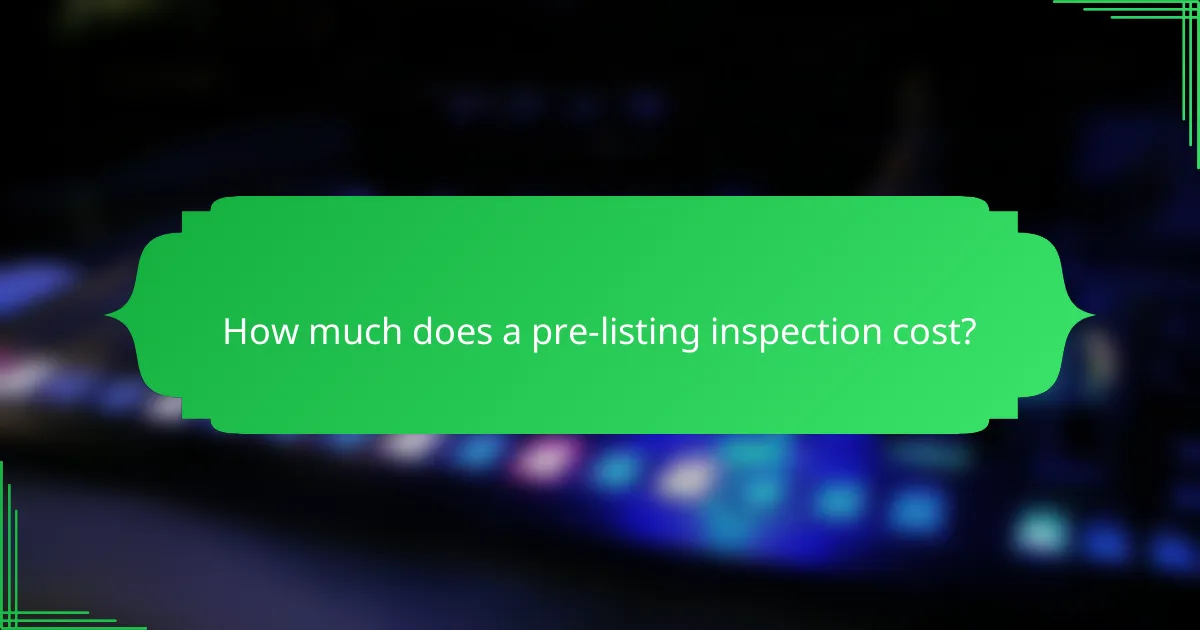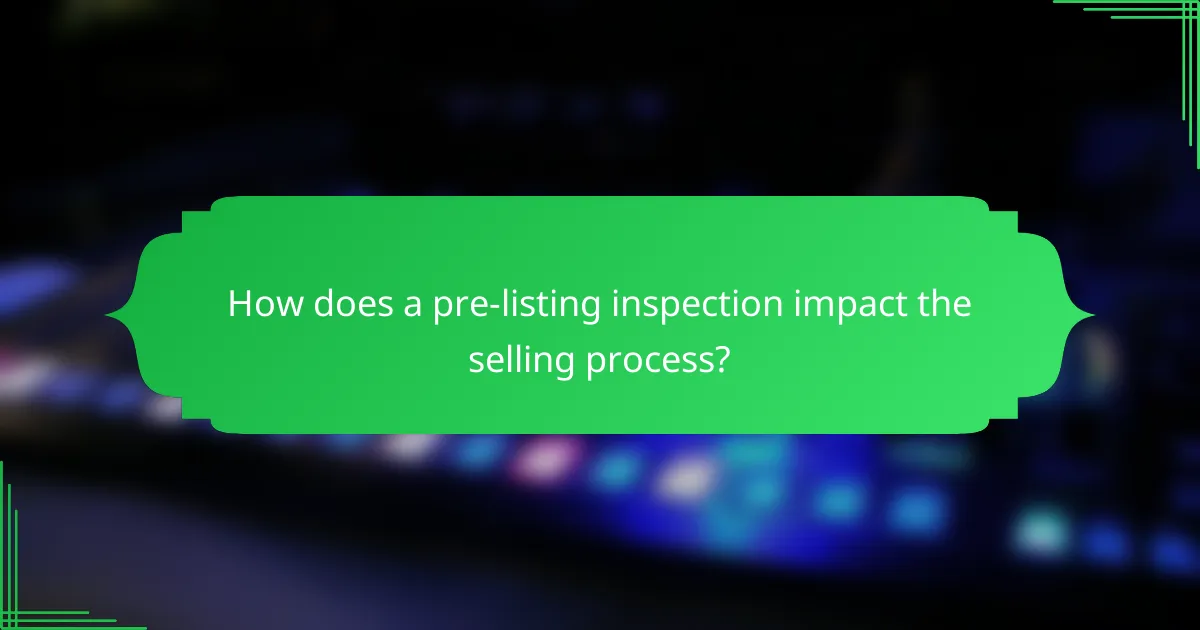A pre-listing inspection is a strategic investment for sellers in the real estate market, offering the opportunity to identify potential issues before listing their property. While the cost of such an inspection can range from a few hundred to over a thousand dollars, the long-term savings from avoiding price reductions and costly repairs can be substantial. By enhancing buyer confidence and facilitating smoother transactions, a pre-listing inspection ultimately contributes to a more efficient selling process.

What are the benefits of a pre-listing inspection in real estate?
A pre-listing inspection offers several advantages for sellers in the real estate market. It helps identify issues before listing, enhances buyer confidence, and facilitates smoother transactions, ultimately leading to a more efficient selling process.
Identifies potential issues
A pre-listing inspection allows sellers to uncover hidden problems in the property, such as plumbing leaks, electrical issues, or structural concerns. By addressing these issues upfront, sellers can avoid surprises during negotiations or after the sale.
Common findings from inspections include outdated wiring, roof damage, or pest infestations. Knowing these details can help sellers make informed decisions about repairs and pricing strategies, potentially saving thousands in last-minute fixes.
Enhances buyer confidence
Providing a pre-listing inspection report can significantly boost buyer confidence. When potential buyers see that a property has been thoroughly inspected and any issues addressed, they are more likely to trust the seller and feel secure in their investment.
This transparency can lead to quicker offers and potentially higher sale prices, as buyers may be willing to pay a premium for a property that has been vetted for problems. A well-documented inspection can serve as a strong selling point in competitive markets.
Facilitates smoother transactions
By identifying and resolving issues before listing, a pre-listing inspection can streamline the entire sales process. Sellers can avoid lengthy negotiations over repairs and reduce the likelihood of contract cancellations due to undisclosed problems.
Additionally, a smoother transaction can lead to faster closings, which is beneficial for both sellers and buyers. Sellers can plan their next steps with certainty, while buyers can move into their new homes without unexpected delays.

How much does a pre-listing inspection cost?
A pre-listing inspection typically costs between a few hundred to over a thousand dollars, depending on various factors. This investment can help sellers identify issues before listing their property, potentially saving them money in the long run by avoiding price reductions or repairs after a buyer’s inspection.
Average cost range
The average cost of a pre-listing inspection generally falls between $300 and $600 for standard residential properties. Larger homes or those with unique features may incur higher fees, sometimes reaching up to $1,000 or more. This cost often includes a detailed report outlining the property’s condition and any necessary repairs.
Factors affecting pricing
Geographic location also impacts pricing; inspectors in urban areas may charge more due to higher living costs. Furthermore, the inspector’s experience and reputation can affect the fee, with more established professionals often commanding higher rates.
Regional pricing variations
Pricing for pre-listing inspections can vary significantly by region. For instance, inspections in metropolitan areas like New York or San Francisco may start at around $500, while rural areas might see costs as low as $300. Understanding local market conditions can help sellers budget appropriately for this service.
In Europe, prices may differ based on local regulations and standards. For example, in Germany, a pre-listing inspection could range from €300 to €800, depending on the property’s specifics. Sellers should research local inspectors to get accurate estimates based on their location.

What potential savings can a pre-listing inspection provide?
A pre-listing inspection can lead to significant savings by identifying issues before they become costly repairs. By addressing these problems early, sellers can enhance their property’s value and streamline the selling process.
Reduces repair costs
By conducting a pre-listing inspection, sellers can uncover hidden issues that might require repairs. Addressing these problems upfront can prevent more extensive and expensive repairs later, which could arise during buyer inspections.
For instance, fixing minor plumbing leaks or electrical issues before listing can save thousands of dollars compared to waiting until a buyer’s inspection reveals them. Sellers can often negotiate better rates with contractors when they have time to shop around.
Avoids price reductions
Buyers often request price reductions based on findings from their inspections. A pre-listing inspection allows sellers to proactively fix issues, reducing the likelihood of price negotiations that could lower their final sale price.
For example, if a roof leak is discovered during a buyer’s inspection, the seller may have to reduce the price by several thousand dollars. By addressing such issues beforehand, sellers can maintain their asking price and avoid losing potential profits.
Minimizes closing delays
Closing delays can be costly and frustrating for both sellers and buyers. A pre-listing inspection helps identify and resolve issues that could otherwise hold up the closing process, ensuring a smoother transaction.
Common issues that can cause delays include title disputes or unresolved repairs. By addressing these proactively, sellers can facilitate a quicker closing, which is beneficial in a competitive market where timing can impact sale outcomes.

What pricing strategies should sellers consider?
Sellers should consider various pricing strategies that align with the findings from a pre-listing inspection. These strategies can help maximize the property’s value while addressing potential issues that may arise during the selling process.
Competitive pricing based on inspection findings
Setting a competitive price involves analyzing the inspection report to identify any repairs or upgrades needed. Sellers can adjust their pricing based on the condition of the property compared to similar homes in the area. For instance, if the inspection reveals minor issues, pricing slightly below market value can attract more buyers.
It’s essential to consider local market conditions and recent sales data when determining a competitive price. Sellers might find that homes in good condition sell for 5-10% more than those needing significant repairs.
Value-added pricing strategies
Value-added pricing strategies involve enhancing the property’s appeal through improvements that justify a higher price. Sellers can invest in cosmetic upgrades or energy-efficient features that can increase the home’s market value. For example, a fresh coat of paint or updated appliances can lead to a price increase of several thousand dollars.
Additionally, sellers can highlight unique features or recent renovations in their listings to attract buyers willing to pay a premium. This strategy can be particularly effective in competitive markets where buyers are looking for move-in-ready homes.
Negotiation tactics post-inspection
After a pre-listing inspection, sellers should be prepared to negotiate based on the findings. If the inspection uncovers issues, sellers can use this information to justify their asking price or negotiate repairs with potential buyers. For instance, if a buyer requests repairs, sellers might offer a credit at closing instead of making the repairs themselves.
Effective negotiation tactics include being transparent about the inspection results and remaining flexible with offers. Sellers should also be ready to highlight any improvements made before listing to strengthen their position during negotiations.

What are the prerequisites for a successful pre-listing inspection?
A successful pre-listing inspection requires careful planning and execution. Key prerequisites include selecting a qualified inspector, preparing the property adequately, and understanding local regulations that may impact the inspection process.
Choosing a qualified inspector
Selecting a qualified inspector is crucial for an effective pre-listing inspection. Look for professionals with relevant certifications, experience in your property type, and positive reviews from past clients. It’s advisable to interview multiple candidates to gauge their expertise and approach.
Consider asking for sample reports and references to ensure the inspector’s thoroughness and attention to detail. A good inspector will not only identify issues but also provide insights on how to address them effectively.
Preparing the property
Preparing your property for inspection can significantly influence the outcome. Start by decluttering spaces and ensuring that all areas are accessible, including attics, basements, and crawl spaces. This allows the inspector to conduct a comprehensive evaluation.
Additionally, consider making minor repairs, such as fixing leaky faucets or replacing burnt-out light bulbs. These small actions can enhance the inspector’s impression and potentially lead to a more favorable report.
Understanding local regulations
Familiarizing yourself with local regulations is essential for a smooth pre-listing inspection. Different regions may have specific requirements regarding safety standards, building codes, and disclosure obligations. Researching these regulations can help you avoid potential pitfalls.
Consult with your real estate agent or a local attorney to ensure compliance with all necessary laws. Being proactive in understanding these regulations can save you time and money in the long run, as it helps prevent issues that could arise during the sale process.

How does a pre-listing inspection impact the selling process?
A pre-listing inspection can significantly enhance the selling process by identifying potential issues before the property hits the market. This proactive approach not only builds buyer confidence but also helps sellers avoid last-minute surprises that could derail a sale.
Streamlines negotiations
A pre-listing inspection streamlines negotiations by providing both buyers and sellers with a clear understanding of the property’s condition. When sellers present a report detailing any issues, it fosters transparency and can reduce the likelihood of disputes over repairs or price adjustments later in the process.
For instance, if a seller addresses minor repairs before listing, they can justify their asking price more effectively. Buyers are often willing to pay a premium for homes that have been inspected and maintained, knowing they face fewer immediate expenses after purchase.
To maximize this benefit, sellers should consider obtaining the inspection report early in the listing process and be prepared to discuss findings openly with potential buyers. This approach can lead to quicker agreements and fewer back-and-forth negotiations.
